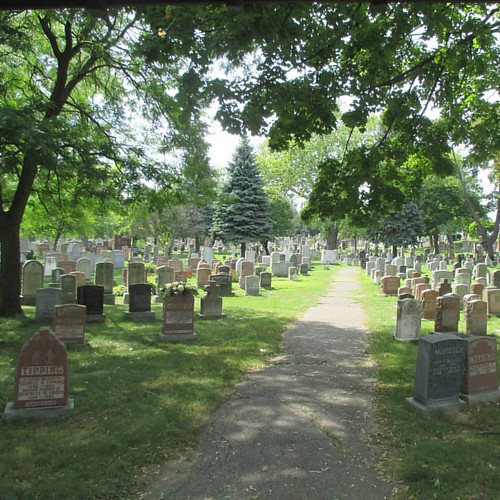- Guelph will be holding an open house to see what development will replace the Dolime Quarry. Global News reports.
- The town of Innisfil has extended its Uber subsidy program for people in need of transit. Global News reports
- Archeologists in Montréal have found a mass grave of Irish famine victims. CTV reports.
- The Québec town of Asbestos is changing its name so as to avoid the link, in English, with the toxic mineral. CTV reports.
- A subway, alas, would be too big for Québec City. Streetcars would work better. Le Devoir reports.
- Can a hyperloop be built to plug Edmonton together with Calgary? Global News considers.
- Richmond, British Columbia, has unveiled a cultural harmony strategy to help its diverse population get along. The National Post reports.
[URBAN NOTE] Seven Toronto links
Nov. 26th, 2019 06:09 pm- John Lorinc at Spacing considers the complication idea of a city charter for Toronto. Is it worth it? Does it ignore other governance issues?
- Tourism is booming in Toronto, transforming the economy of the metropolis. The Toronto Star reports.
- NOW Toronto notes how the Toronto District School Board is introducing educational courses intended to prepare students for careers in hospitality.
- Legal controversy surrounding the governance of Mount Pleasant Cemetery, and other like cemeteries in Toronto, is ongoing. The Toronto Star reports.
- In Milton, the owner of an illegal rooming house where one tenant died has been found financially liable. CBC reports.
- The Toronto Star tells the story of soldiers returning from the First World War who attacked Chinatown and its inhabitants, here.
- NOW Toronto points to an exhibition of photos created in solidarity with Hong Kong journalists.
[URBAN NOTE] Eight Toronto links
Oct. 24th, 2019 01:44 pm- Samantha Edwards writes</> at NOW Toronto about the controversy surrounding the visit of transphobe author Meghan Murphy to give a speech at the Palmerston library, with authors even threatening a boycott of the network.
- Natasha Tusikov writes at The Conversation about how Sidewalk Labs' proposals for the Port Lands would give it great and unaccountable political power.
- blogTO looks at the 1945 proposal for a subway in Toronto, one with a west-east axis not on Bloor but further south on Queen.
- blogTO looks at Sparkles, the nightclub at the top of the CN Tower that reigned over the Toronto scene in the 1980s.
- Will the Scarborough neighbourhood of Brichcliffe-Cliffside by changed for the worse by new dense construction? The Toronto Star reports.
- People who, in illegally climbing the Scarborough Bluffs, get trapped on said feature might soon be charged with the costs of their own rescue. blogTO reports.
- The growth of popularity of specifically Toronto slang is fascinating. Global News reports.
- Jamie Bradburn shares an old article on St. John's Norway cemetery, here.
- JSTOR Daily looks at how, in the 19th century, many cities made their cemeteries into parks.
- Guardian Cities considers which city in the world is the hardest-drinking one.
- CityLab notes that building cities is not going to be the answer to global warming.
- The Conversation looks at the demographics of the homeless of North America.
- The threat of Donald Trump to send undocumented immigrants to sanctuary cities in the United States has widely noted. Maybe this actually might be a good solution? Global News reports.
- Urban Toronto notes that it will be bringing back its Growth to Watch For series in 2019.
- The Province of Ontario has made a formal request for the TTC's data to determine the organization's worth, preparing for a takeover. The Globe and Mail reports.
- The trial of the Church and Wellesley serial killer is expected to start in 2020. The Globe and Mail reports.
- What happened to the body of young pioneer girl Stella Vanzant, buried in a location now somewhere in the Financial District? The Globe and Mail looks at the question.
- blogTO takes a look at Viryl Technology, a local manufacturer of vinyl pressing plant equipment, with photos, here.
I would have liked to have spent more time in the Toronto Necropolis, but at this point of the year the cemetery's gates close at 5:30. I only had enough time to dip briefly into the cemetery off of Winchester Street, take a look, and dip out. I need to spend more time there: In the light of a fall twilight, this place is gorgeous.

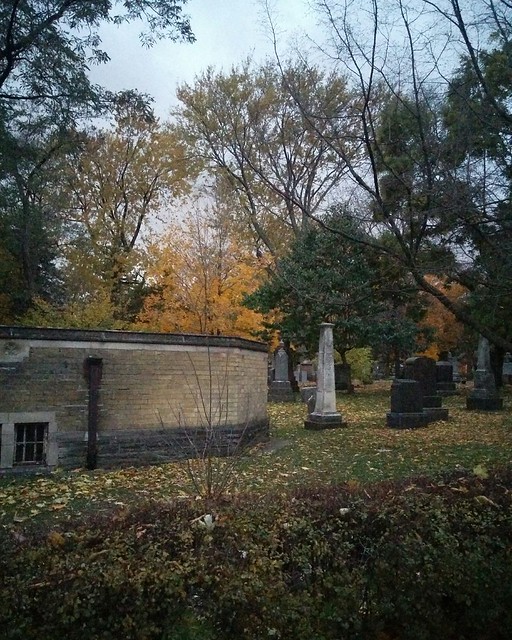


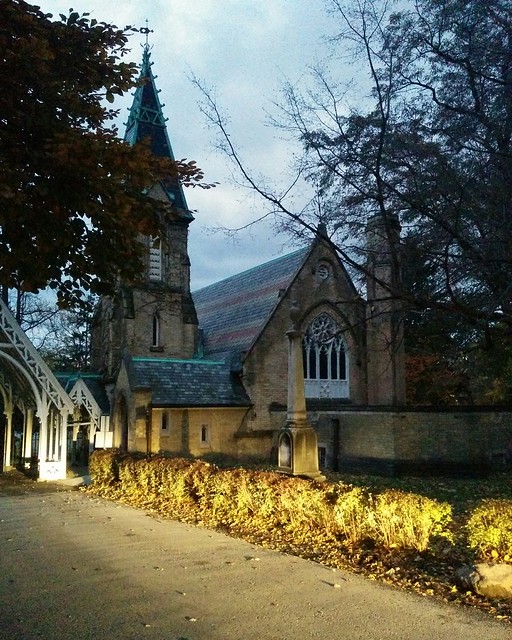





- Atlas Obscura notes, unsurprisingly, that some cemeteries in the United States were used as parks. Why not? These can be lovely green spaces. Just look at Toronto's Mount Pleasant and Prospect cemeteries.
- Meg Holden at The Conversation takes a look at the language, the grammar of thought, used to praise cities this day. Have we gone too far away from the skepticism of earlier decades?
- The Guardian Cities reports on NUMTOTs, "New Urbanist Memes for Transit-Oriented Teens", the Facebook group oriented to young urbanist fans that is hugely popular. (I've joined, I admit.)
- Open Democracy carries French-Iranian sociologist Farhad Khosrokhavar article on "jihadogenous urban structures", on neighbourhoods which can alienate young people to the point of supporting Islamist terror.
- Guardian Cities shares photos of some of the bold concrete architecture developed in Yugoslavia.
- Wired noted how Arctic cities were facing significant problems from melting permafrost, and how they were trying to deal with this threat.
- CityLab notes the ever-popular idea of a floating city, riding the waves.
- Atlas Obscura notes, unsurprisingly, that some cemeteries in the United States were used as parks. Why not? These can be lovely green spaces. Just look at Toronto's Mount Pleasant and Prospect cemeteries.
- In a feature on Menno Schilthuizen's Darwin Comes to Town, Simon Worrall at National Geographic looks at the many and varied ways wildlife can adapt to city life.
- Melissa Byrnes, at Lawyers, Guns and Money, noted how Trump's rhetoric of ICE "liberating" American communities echoed ways in which French authorities in the Algerian war militarized immigrant neighbourhoods.
On this chilly late fall day, I decided to revisit a series of photographs I had taken in Prospect Cemetery back in September, when all was warm and green and full of light. These spaces can be wonderful places to explore, full of life and the commemoration of those who we still hold dear.












































- Torontoist's Historicist takes a look at the issue of improving the grave of William Lyon Mackenzie in the 1930s.
- Norman Wilner celebrates the newly reopened Cinesphere, down at a reenergizing Ontario Place.
- Alex Bozikovic celebrates the beautiful new renovation and expansion of HIV/AIDS hospice Casey House.
- John Lorinc notes the many potential problems with the investments of Google's Sidewalk in Quayside.
- Vjosa Isai celebrates the 30th anniversary of a mural that helped name, and give shape, to Leslieville, over at the Toronto Star.
- Torontoist takes a look at why William Lyon Mackenzie King thought he needed to revamp his grandfather's grave.
- Dylan Reid at Spacing argues against distracted walking laws, on the grounds they excuse drivers of vehicles.
- Jennifer Yang notes the transformation of Little China in Scarborough from a Hong Kong enclave to a blue-collar mainland Chinese one.
- Global News notes that Toronto has been named a UNESCO Creative City of Media Arts, one of ten worldwide.
- Plans are afoot to make Kipling Station, westernmost TTC station, much more of a regional transit hub.
- John Lorinc takes a closer look at what, exactly, Google's Sidewalk Labs hopes to do with Quayside.
On this chill afternoon one day after Hallowe'en night, it struck me as entirely appropriate to go through photos I had taken of the Toronto Necropolis one fine warm fall afternoon, bright with sunshine and green with life. The Necropolis is a solemn memorial, but it is also an enjoyable park. More people should visit, I think, to enjoy this space, with remarkable individual graves embedded in the great sweep of life that has sprung up above this commemorated death on Cabbagetown's slopes above the Don Valley.


























































The Necropolis Chapel is a lovely small quiet building located near the southern entrance of the Toronto Necropolis cemetery in Cabbagetown. I find it a lovely space to sit, and reflect.
Besides the architecture, on this visit I was struck by one particular memorial, purple flowers highlighting the memorial plaque of Paul Noble Bartlett, born in 1955 and died in 1988. What, I wonder, was his story? The bare bones idea of a Toronto man who died, so early, in his 30s back in the 1980s brings the HIV/AIDS epidemic to my mind, but different searches have turned up nothing apart from memorials to his parents, dead two or three decades later. What was his story? Who placed those flowers there?
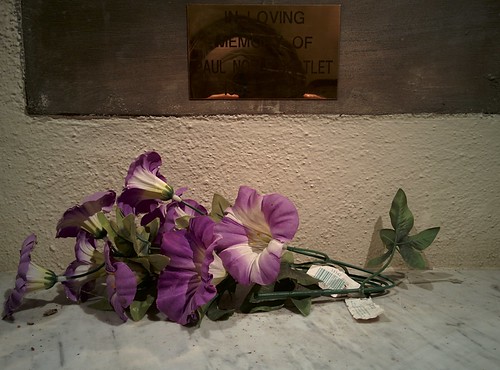
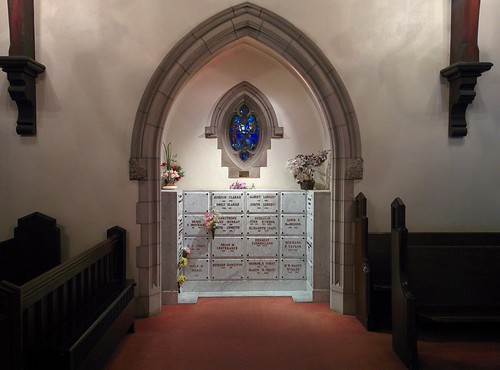
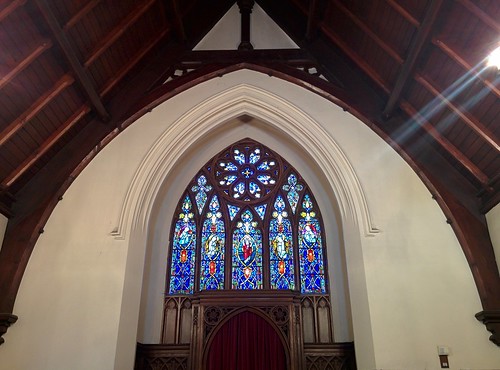
Besides the architecture, on this visit I was struck by one particular memorial, purple flowers highlighting the memorial plaque of Paul Noble Bartlett, born in 1955 and died in 1988. What, I wonder, was his story? The bare bones idea of a Toronto man who died, so early, in his 30s back in the 1980s brings the HIV/AIDS epidemic to my mind, but different searches have turned up nothing apart from memorials to his parents, dead two or three decades later. What was his story? Who placed those flowers there?



- Bloomberg notes global warming can expose New York City to heightened flood risks every five years, not every 500.
- Saudi Arabia, Bloomberg notes, plans to build a new city from scratch.
- VICE notes that Hong Kong, with its dear real estate, is running out of space for its dead.
- Spacing looks at how Mexico City is expanding its cycling infrastructure as part of its bid for world status.
The Cavendish Cemetery, on the southwest corner of the intersection of routes 6 and 13, is famous around the world as the place where Lucy Maud Montgomery rests in eternal peace. Alongside her are buried many of her relatives, including her mother and her maternal grandparents, MacNeills all. A sign at the entrance asks visits not to leave artificial flowers.






Prospect Cemetery is different in some noteworthy ways from Mount Pleasant Cemetery, the burying ground that is a natural match for it in size and location. Mount Pleasant is arguably defined by graves of people of British background, sober monuments in stone towering above the lanes. Prospect Cemetery's graves are more multicultural, the graves of southern and eastern Europeans being especially prominent. My eye was caught especially by particular graves, of people of Portuguese background, which were tended to marvelously, bedecked with flowers and grave goods by people who cared.








Last Thursday, together with Facebook's Mark I wandered around Toronto's Mount Pleasant Cemetery. A vast park-like expanse now surrounded by the midtown, when it was created in the 1880s it was outside of the city's northern boundaries. Under the heavy first layer of snow this winter, Mount Pleasant was quiet and at peace.
These seventeen are only a small fraction of all the photos I took here that day. A Facebook album hosts all 115 of the photos I took around Mount Pleasant.
















These seventeen are only a small fraction of all the photos I took here that day. A Facebook album hosts all 115 of the photos I took around Mount Pleasant.
















A Google search for St. Columba Presbyterian Church, located in the unincorporated community of Marshfield to the immediate northeast of Charlottetown, brings up nothing but links to church directories and snippets from Google Books. I know of this church from my years as a cyclist on the Island, as this church and the hill it lies on was the furthest distance from home that I would ever bike.
The church's cemetery is lovely, peaceful despite its closeness to the St. Peter's Road. The monuments to past tragedies--a woman dead at 29, a couple buried next to each other, a monument to unnamed lost children--are in a good place.






The church's cemetery is lovely, peaceful despite its closeness to the St. Peter's Road. The monuments to past tragedies--a woman dead at 29, a couple buried next to each other, a monument to unnamed lost children--are in a good place.






[PHOTO] From St. John's Norway Cemetery
Aug. 10th, 2016 03:13 pmSt. John's Norway Cemetery, located on the northwestern corner of Kingston Road and Woodbine Avenue in the east end, is a historic cemetery known for housing the final resting places not of Toronto's richest but rather of the middle and lower classes, going back 160 years.

